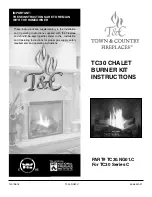
20
●
Tanks must be stored outdoors out of the reach of children. Do NOT store in a building, garage, or any
other enclosed area.
●
Never store your LP gas tank where temperatures can reach over 125°F.
●
Do not store the LP gas cylinder in direct sunlight or near a source of heat or combustion.
●
Never keep a filled LP gas tank in a hot car or car trunk. Heat will cause the gas pressure to increase, which
may open the relief valve and allow gas to escape.
●
Place dust cap on valve outlet whenever the LP gas tank is not in use. Only install the type of dust cap on
the LP gas tank valve outlet that is provided with the LP gas tank valve. Other types of caps or plugs may
result in leakage of propane.
●
Do not store a spare LP gas cylinder under or near this appliance.
●
Never fill the LP gas cylinder beyond 80% full.
●
If the information in (a) and (b) is not followed exactly, a fire causing death or serious injury may occur.
●
LP gas cylinders should be filled only by a certified LP gas dealer.
●
The pressure regulator is set for 28-30 mbar, 37 mbar or 50mbar. The gas regulator has to be set according
to specific gas category (see on data plate). The regulator should comply with EN 16129 standard.
●
Regulator outlet pressure is 28-30 mbar, 37 mbar or 50 mbar.
●
Never attempt to attach this appliance to the self-contained LP gas system of a camper trailer, motor
home or house.
●
Always use the pressure regulator and hose assembly provided with the appliance to connect to a LP gas
cylinder. Never connect to an unregulated LP gas supply.
●
Contact your retailer’s customer service department for replacement parts.
●
Hand turn the manual gas control valve. Never use tools. If the valve will not turn by hand, do not try to
repair it. Call a certified gas technician. The use of force or any self-attempted repair may result in a fire or
explosion.
●
Use only the type of gas and the type of LPG cylinder specified by the manufacturer.
●
Appliance is fitted with gas regulator, flexible gas rubber pipe and clamps according to the National Rules
in force of the country of destination.
●
Appliance must use an approved gas regulator (approved for a working temperature not lower than 50
˚C) according to the EN Standard (see minimum, nominal and maximum pressure - gas regulator inlet
and outlet connection according to the National Rules in force) and flexible gas hose according to EN
Standard (with proper inner diameter according to gas inlet connection and National Rules in force) with
a length not over 1.5 m and approved for a working temperature not lower than 60 ˚C. When substitution
will be necessary, you have to purchase suitable gas regulator, flexible gas rubber pipe and clamps from
your local gas dealer; gas regulator should be substituted not over 10 years.
●
Flexible gas rubber pipe must be carefully, avoiding any twisting. Never use a damaged gas regulator.
●
Never connect this appliance to an unregulated LPG source (gas regulator is mandatory to be used).
●
When the appliance is not in use, turn the LPG cylinder in “OFF” position.
●
Always perform a leakage test on gas connections whenever a LPG cylinder is connected. If bubbles form
in Flexible gas rubber pipe must be located in the LPG compartment carefully, avoiding any twisting.
●
Never use a damaged gas regulator.
●
Always perform a leakage test on gas connections whenever a LPG cylinder is connected. If bubbles form
in the leakage test solution, do not use it. Never use a flame to test for leakages.
It is strictly forbidden and dangerous!
Manual ATRIO.indd 20
30/4/21 13:29
Содержание ATRIO
Страница 54: ...Manual ATRIO indd 54 30 4 21 13 29...
Страница 56: ...Manual ATRIO indd 56 30 4 21 13 29...
















































